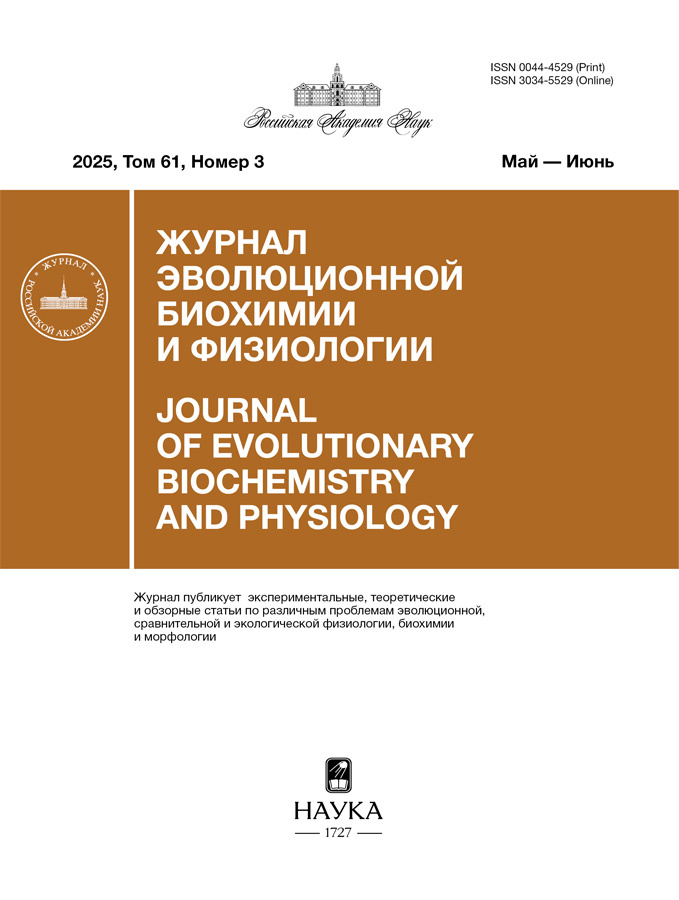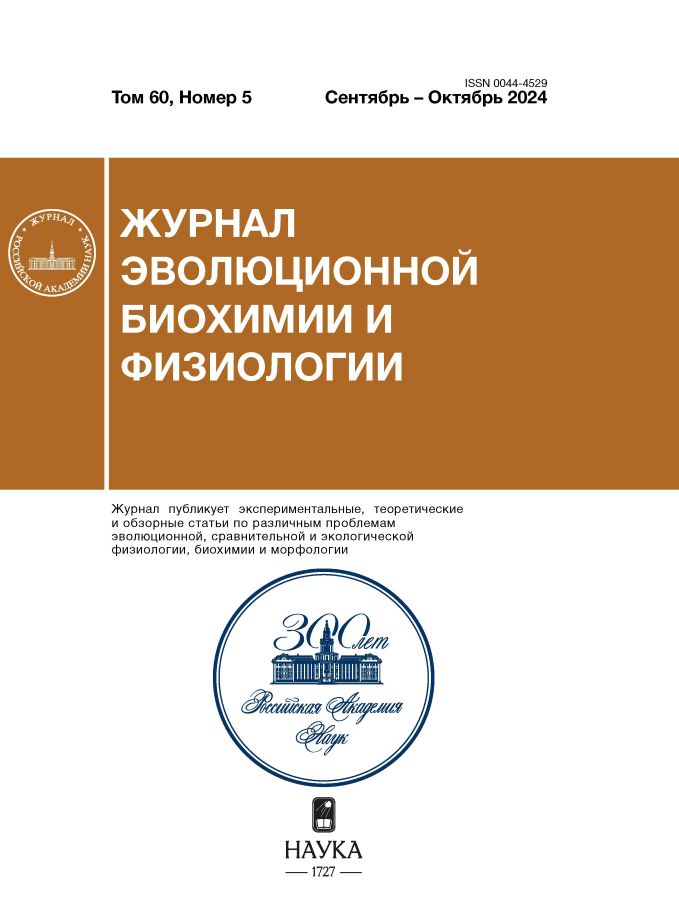Механизмы вовлечения моноаминоксидазы в развитие гипербарических кислородных судорог
- Авторы: Жиляев С.Ю.1, Басова И.Н.1, Платонова Т.Ф.1, Алексеева О.С.1, Гавришева Н.А.2, Демченко И.Т.1
-
Учреждения:
- Институт эволюционной физиологии и биохимии им. И.М. Сеченова РАН
- Первый Санкт-Петербургский государственный медицинский университет им. И.П. Павлова
- Выпуск: Том 60, № 5 (2024)
- Страницы: 526-534
- Раздел: ЭКСПЕРИМЕНТАЛЬНЫЕ СТАТЬИ
- URL: https://rjeid.com/0044-4529/article/view/648109
- DOI: https://doi.org/10.31857/S0044452924050069
- EDN: https://elibrary.ru/XPEPWU
- ID: 648109
Цитировать
Полный текст
Аннотация
Дыхание гипербарическим кислородом (ГБО2) вызывает генерализованные тонические и клонические судороги, механизмы возникновения которых недостаточно изучены. Целью настоящей работы являлось исследование механизмов вовлечения моноаминоксидазы (МАО) в развитие гипербарических кислородных судорог. У крыс, находящихся в барокамере под давлением кислорода 5 АТА, анализировали судорожные реакции после введения пиразидола — ингибитора МАО-А и паргилина — ингибитора МАО-Б. Исследования показали снижение активности МАО-изоформ в ГБО2, а также задержку развития судорог у животных при ингибировании МАО-А и МАО-Б. Уровень ГАМК в мозге понижался при ГБО2, а ингибирование МАО-Б с помощью паргилина предотвращало снижение содержания тормозного медиатора. Полученные результаты свидетельствуют о том, что МАО-изоформы играют важную роль в регулировании эпилептогенеза при экстремальной гипероксии. Гипербарический кислород, ингибируя каталитическую активность МАО путем трансформации ее молекулярной структуры, приводит к нарушению регуляции обмена моноаминовых нейротрансмиттеров и понижению уровня ГАМК в мозге, что в совокупности ведет к дисбалансу процессов возбуждения/торможения в ЦНС, лежащему в основе патогенеза кислородной эпилепсии.
Ключевые слова
Полный текст
Об авторах
С. Ю. Жиляев
Институт эволюционной физиологии и биохимии им. И.М. Сеченова РАН
Email: osa72@inbox.ru
Россия, Санкт-Петербург
И. Н. Басова
Институт эволюционной физиологии и биохимии им. И.М. Сеченова РАН
Email: osa72@inbox.ru
Россия, Санкт-Петербург
Т. Ф. Платонова
Институт эволюционной физиологии и биохимии им. И.М. Сеченова РАН
Email: osa72@inbox.ru
Россия, Санкт-Петербург
О. С. Алексеева
Институт эволюционной физиологии и биохимии им. И.М. Сеченова РАН
Автор, ответственный за переписку.
Email: osa72@inbox.ru
Россия, Санкт-Петербург
Н. А. Гавришева
Первый Санкт-Петербургский государственный медицинский университет им. И.П. Павлова
Email: osa72@inbox.ru
Россия, Санкт-Петербург
И. Т. Демченко
Институт эволюционной физиологии и биохимии им. И.М. Сеченова РАН
Email: osa72@inbox.ru
Россия, Санкт-Петербург
Список литературы
- Зальцман ГЛ (1968) Стадии развития кислородной эпилепсии и функциональное состояние нервной системы. В кн. Гипербарические эпилепсия и наркоз. Л. Наука. С. 129–136. [Zal’tsman GL (1968) Stages of formation of oxygen-induced epilepsy and the functional state of the nervous system. In: Hyperbaric Epilepsy and Narcosis: Neurophysiological Studies (in Russion with English abstracts). Zal’tsman GL (ed.). Nauka. Leningrad, pp. 129–136.]
- Bean JW, Zee D, Thom B (1966) Pulmonary changes with convulsions induced by drugs and oxygen at high pressure. J Appl Physiol 21(3): 865–872. https://doi.org/10.1152/jappl.1966.21.3.865
- Dean JB, Mulkey DK, Henderson RA 3rd, Potter SJ, Putnam RW (2004) Hyperoxia, reactive oxygen species, and hyperventilation: oxygen sensitivity of brain stem neurons. J Appl Physiol (1985) 96(2): 784–791. https://doi.org/10.1152/japplphysiol.00892.2003
- Gasier HG, Demchenko IT, Zhilyaev SY, Moskvin AN, Krivchenko AI, Piantadosi CA (2018) Adrenoceptor blockade modifies regional cerebral blood flow responses to hyperbaric hyperoxia: protection against CNS oxygen toxicity. J Appl Physiol (1985) 125(4): 1296–1304. https://doi.org/10.1152/japplphysiol.00540.2018
- Platonova TF, Alekseeva OS, Nikitina ER, Demchenko IT (2020) Blockade of Brain Adrenoreceptors Delays Seizure Development during Hyperbaric Oxygen Breathing. J Evol Biochem Phys 56(5): 425–433. https://doi.org/10.1134/S0022093020050051
- Glover V, Gibb C, Sandler M (1986) The role of MAO in MPTP toxicity. J Neural Transm Suppl 20: 65–76.
- Knoll J (1978) On the dual nature of monoamine oxidase. Horiz Biochem Biophys 5: 37–64.
- Magyar K (1993) Pharmacology of monoamine oxidase type B inhibitors. In: Inhibitors of Monoamine Oxidase B. Pharmacology and Clinical Use in Neurodegenerative Disorders (ed. Szelenyi I) Birkhauser, Basel 125–143.
- Yusa T, Beckman JS, Crapo JD, Freeman BA (1987) Hyperoxia increases H2O2 production by brain in vivo. J Appl Physiol (1985) 63(1): 353–358. https://doi.org/10.1152/jappl.1987.63.1.353.PMID: 362413
- Demchenko IT, Zhilyaev SY, Moskvin AN, Piantadosi CA, Allen BW (2010) Autonomic activation links CNS oxygen toxicity to acute cardiogenic pulmonary injury. Am J Physiol Lung Cell Mol Physiol 300(1): L102–111. https://doi.org/10.1152/ajplung.00178.2010
- Горошинская ИА, Кричевская АА, Шугалей ВС, Шерстнев КБ, Баламирзоева РМ (1986) Активность моноаминоксидазы и уровень гамма-аминомасляной кислоты при гипероксии, влияние хлоргилина. Вопросы медицинской химии 32(2): 76–79. [Goroshinskaia IA, Krichevskaia AA, Shugaleĭ VS, Sherstnev KB, Balamirzoeva RM (1986) Monoamine oxidase activity and gamma-aminobutyric acid levels in hyperoxia. The effect of clorgyline. Vopr Med Khim 32(2): 76–79.]
- Medvedev AE, Rajgorodskaya DI, Gorkin VZ, Fedotova IB, Semiokhina AF (1992) The role of lipid peroxidation in the possible involvement of membrane-bound monoamine oxidases in gamma-aminobutyric acid and glucosamine deamination in rat brain. Focus on chemical pathogenesis of experimental audiogenic epilepsy. Mol Chem Neuropathol 16(1–2): 187–201. https://doi.org/10.1007/BF03159969
- Bruhwyler J, Liégeois JF (1997) Pirlindole: a selective reversible inhibitor of monoamine oxidase A. A review of its preclinical properties. Géczy J Pharmacol Res 36(1): 23–33. https://doi.org/10.1006/phrs.1997.0196
- Lowry OH, Rosebrough NJ, Farr AL, Randall RJ (1951) Protein measurement with the Folin phenol reagent. J Biol Chem 193(1): 265–275.
- Северина ИС (1979) О возможном механизме избирательного торможения хлоргилином и депренилом активности митохондриальной моноаминоксидазы печени крыс. Биохимия 44(2): 195–207. [Severina IS (1979) Possible mechanism of selective inhibition of rat liver mitochondrial monoamine oxidase by chlorgiline and deprenyl. Biokhimiia. 44(2): 195–207. (In Russ)].
- Стрелков РБ (1967) К модификации методики изотермической перегонки аммиака. Лабораторное дело. 1: 17–19. [Strelkov RB (1967) On the modification of the method of isothermic sublimation of ammonia. Lab Delo. 1: 17–19. (In Russ)].
- Zhang J, Piantadosi CA (1991) Prevention of H2O2 generation by monoamine oxidase protects against CNS O2 toxicity. J Appl Physiol (1985) 71(3): 1057–1061. https://doi.org/10.1152/jappl.1991.71.3.1057
- Paxinos G, Watson C (2005) The Rat Brain in Stereotaxic Coordinates. Boston, MA: Elsevier.
- Demchenko IT, Luchakov YuI, Moskvin AN, Gutsaeva DR, Allen BW, Thalmann ED, Piantadosi CA (2005) Cerebral blood flow and brainoxygenation in rats breathing oxygen under pressure. J Cereb Blood Flow Metab 25(10): 1288–1300. https://doi.org/10.1038/sj.jcbfm.9600110
- Racine RJ (1972) Modification of seizure activity by electrical stimulation. II. Motor seizure. Electroencephalogr Clin Neurophysiol 32(3): 281–294. https://doi.org/10.1016/0013-4694(72)90177-0
- Faiman MD, Nolan RJ, Baxter CF, Dodd DE (1977) Brain gamma-aminobutyric acid, glutamic acid decarboxylase, glutamate, and ammonia in mice during hyperbaric oxygenation. J Neurochem 28(4): 861–865. https://doi.org/10.1111/j.1471-4159.1977.tb10640.x
- Piantadosi CA, Tatro LG (1990) Regional H2O2 concentration in rat brain after hyperoxic convulsions. J Appl Physiol (1985) 69(5): 1761–1766. https://doi.org/10.1152/jappl.1990.69.5.1761
- D'Agostino DP, Putnam RW, Dean JB (2007) Superoxide (•O2–) production in CA1 neurons of rat hippocampal slices exposed to graded levels of oxygen. J Neurophysiol 98(2): 1030–1041. https://doi.org/10.1152/jn.01003.2006
- Ciarlone GE, Dean JB (2016) Normobaric hyperoxia stimulates superoxide and nitric oxide production in the caudal solitary complex of rat brain slices. Am J Physiol Cell Physiol 311(6): C1014–C1026. https://doi.org/10.1152/ajpcell.00160.2016
- Oury TD, Ho YS, Piantadosi CA, Crapo JD (1992) Extracellular superoxide dismutase, nitric oxide, and central nervous system O2 toxicity. Proc Natl Acad Sci U S A 89(20): 9715–9719. https://doi.org/10.1073/pnas.89.20.9715
- Arai M, Takata K, Takeda Y, Mizobuchi S, Morita K (2011) The excitement of multiple noradrenergic cell groups in the rat brain related to hyperbaric oxygen seizure. Acta Med Okayama 65(3): 163–168. https://doi.org/10.18926/AMO/46627 PMID: 21709713
- Fitzgerald PJ (2010) Is elevated norepinephrine an etiological factor in some cases of epilepsy? Seizure 19(6): 311–318. https://doi.org/10.1016/j.seizure.2010.04.011
- Finberg JP (2014) Update on the pharmacology of selective inhibitors of MAO-A and MAO-B: focus on modulation of CNS monoamine neurotransmitter release. Pharmacol Ther 143(2): 133–152. https://doi.org/10.1016/j.pharmthera.2014.02.010
- Demchenko IT, Zhilyaev SY, Moskvin AN, Piantadosi CA, Allen BW (2011) Autonomic activation links CNS oxygen toxicity to acute cardiogenic pulmonary injury. Am J Physiol Lung Cell Mol Physiol 300(1): L102–111. https://doi.org/10.1152/ajplung.00178.2010
- Adachi YU, Watanabe K, Hideyuki Higuchi H, Tetsuo Satoh T, Vizi ES (2001) Oxygen inhalation enhances striatal dopamine metabolism and monoamineoxidase enzyme inhibition prevents it: a microdialysis study. Eur J Pharmacol 422(1-3): 61–68. https://doi.org/10.1016/s0014-2999(01)01074-3
- Cho HU, Kim S, Sim J, Yang S, An H, Nam MH, Jang DP, Lee CJ (2021) Redefining differential roles of MAO-A in dopamine degradation and MAO-B in tonic GABA synthesis. Exp Mol Med 53(7): 1148–1158. https://doi.org/10.1038/s12276-021-00646-3
- Pacia SV, Doyle WK, Broderick PA (2001) Biogenic amines in the human neocortex in patients with neocortical and mesial temporal lobe epilepsy: identification with in situ microvoltammetry. Brain Res 899(1-2): 106–111. https://doi.org/10.1016/s0006-8993(01)02214-4
- Lavoute C, Weiss M, Risso JJ, Rostain JC (2014) Alteration of striatal dopamine levels under various partial pressure of oxygen in pre-convulsive and convulsive phases in freely-moving rats. Neurochem Res 39(2): 287–294. https://doi.org/10.1007/s11064-013-1220-z
- Gorkin VZ (1985) Studies on the nature and specific inhibition of monoamine oxidases. In Neuropharmacology 85 (eds. Kelemen K, Magyar K, Vizi ES). Akademiai Kiodo, Budapest 9–14.
- Hess DT, Stamler JS (2012) Regulation by S-nitrosylation of protein post-translationalmodification. J Biol Chem 287(7): 4411–4418. https://doi.org/10.1074/jbc.R111.285742
Дополнительные файлы















